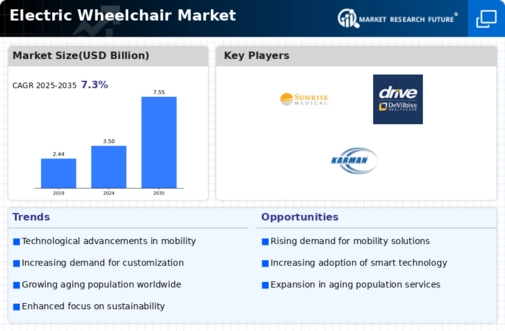Market Analysis
In-depth Analysis of Electric Wheelchair Market Industry Landscape
The global electric wheelchair market has experienced significant growth in recent years, driven by increasing awareness about mobility assistance devices and a growing elderly population worldwide.
Regional Analysis : North America dominates the market, attributed to a high prevalence of disabilities and favorable reimbursement policies. Europe follows closely behind, with a strong emphasis on technological advancements and accessibility initiatives. Asia-Pacific is emerging as a lucrative market, propelled by improving healthcare infrastructure and rising disposable incomes.
Key Market Players : Industry leaders such as Invacare Corporation, Pride Mobility Products Corp., and Permobil AB hold substantial market shares, leveraging their extensive product portfolios and widespread distribution networks.
Technological Innovations : Advances in battery technology, motor efficiency, and smart connectivity features are driving product innovation, enhancing user experience, and increasing the adoption of electric wheelchairs.
Market Trends : A shift towards lightweight and foldable designs for improved portability, coupled with a growing demand for customizable and aesthetically pleasing models, reflects evolving consumer preferences.
Regulatory Landscape : Stringent regulations regarding product safety, quality standards, and medical device approvals influence market dynamics, shaping competitive strategies and market entry barriers.
Distribution Channels : Traditional distribution channels, including dealers, distributors, and healthcare providers, remain prominent. However, online retail platforms are gaining traction, offering convenience and a wider product selection.
Consumer Demographics : Rising geriatric population, increasing prevalence of mobility impairments due to chronic conditions, and greater awareness about accessibility rights are driving demand for electric wheelchairs across age groups.
Price Analysis : Pricing strategies vary based on product features, brand reputation, and target market segments. Price sensitivity among consumers, particularly in developing regions, necessitates competitive pricing and value-added offerings.
Market Challenges : Limited accessibility infrastructure in developing regions, reimbursement uncertainties, and concerns regarding product affordability pose challenges for market expansion and penetration.
Opportunities for Growth : Collaborations with healthcare organizations, government initiatives promoting inclusive mobility solutions, and expanding distribution networks into untapped regions offer avenues for market growth and diversification.
Impact of COVID-19 : The pandemic has accelerated the adoption of telehealth services, prompting manufacturers to incorporate remote monitoring and telemedicine capabilities into electric wheelchair designs, ensuring continuity of care and enhancing user safety.
Sustainability Initiatives : Increasing focus on sustainable manufacturing practices, recyclability of materials, and energy-efficient design solutions align with global environmental concerns and influence purchasing decisions.
Competitive Strategies : Market players are focusing on product differentiation, geographic expansion, mergers and acquisitions, and investment in research and development to gain a competitive edge and enhance market share.
Future Outlook : With ongoing technological advancements, rising healthcare expenditure, and a growing aging population, the global electric wheelchair market is poised for continued growth, offering lucrative opportunities for existing and new market entrants.









Leave a Comment